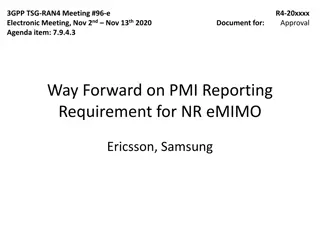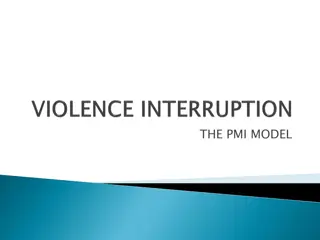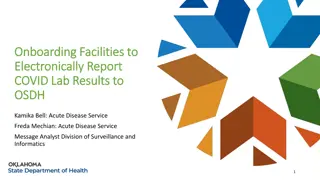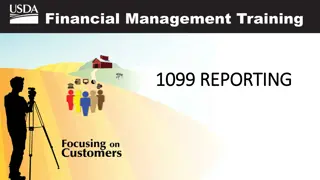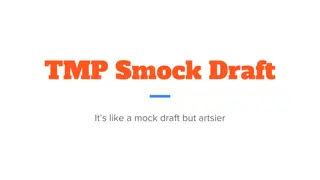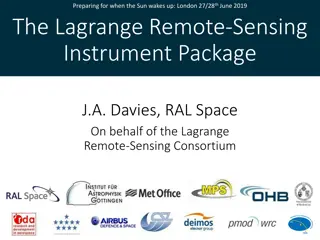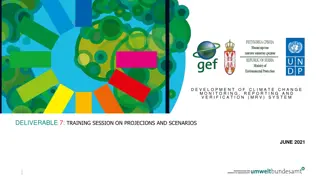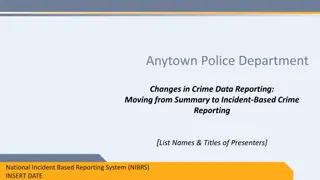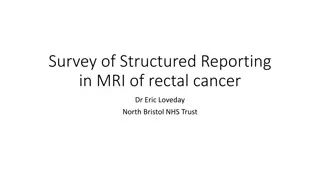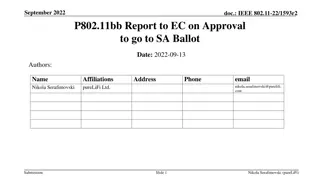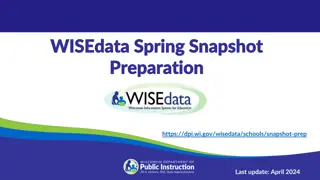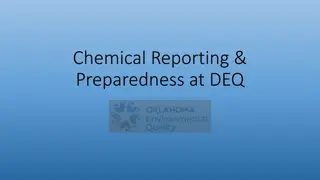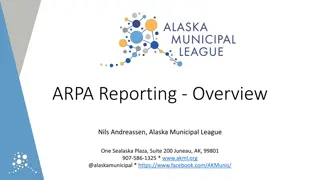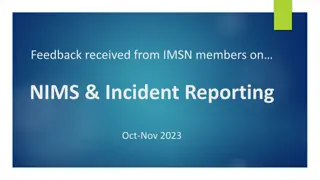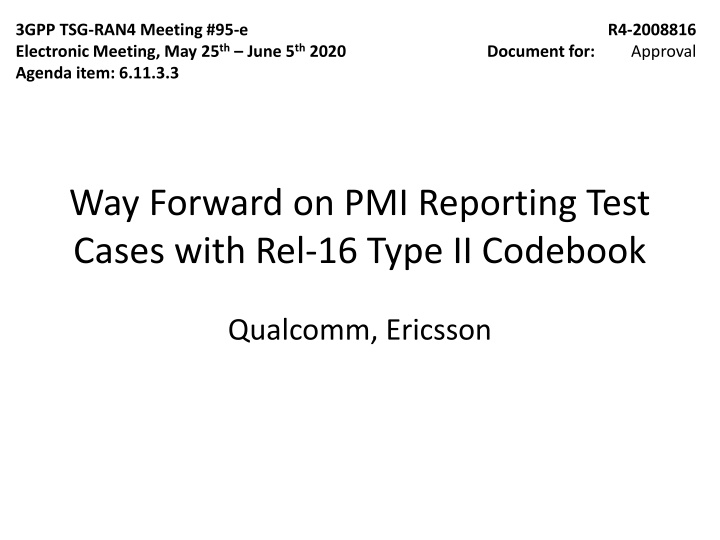
Advanced Test Setup for PMI Reporting in Rel-16 Type II Codebook
Explore the detailed test setup options for PMI reporting with enhanced Type II codebook in 3GPP TSG-RAN4 Meeting #95-e. Options include SU-MIMO and MU-MIMO setups, test parameters, codebook configurations, beam-steering models, and channel models. Feedback from TE vendors is encouraged to ensure compliance with PMI reporting requirements.
Download Presentation

Please find below an Image/Link to download the presentation.
The content on the website is provided AS IS for your information and personal use only. It may not be sold, licensed, or shared on other websites without obtaining consent from the author. If you encounter any issues during the download, it is possible that the publisher has removed the file from their server.
You are allowed to download the files provided on this website for personal or commercial use, subject to the condition that they are used lawfully. All files are the property of their respective owners.
The content on the website is provided AS IS for your information and personal use only. It may not be sold, licensed, or shared on other websites without obtaining consent from the author.
E N D
Presentation Transcript
3GPP TSG-RAN4 Meeting #95-e Electronic Meeting, May 25th June 5th2020 Agenda item: 6.11.3.3 R4-2008816 Approval Document for: Way Forward on PMI Reporting Test Cases with Rel-16 Type II Codebook Qualcomm, Ericsson
Enhanced Type II Test Setup Test setup: Option 1: Only use SU-MIMO test setup, i.e., one tested UE Option 2: MU-MIMO based test setup, i.e., one tested UE + one co- scheduled UE (generated by TE) The baseline receiver assumption is UE without interference cancellation capability with/without co-scheduled UE. Under the baseline UE receiver assumption, the PMI calculation processing will not change with and without co-scheduled UE. TE vendors are encouraged to provide feedback for the test feasibility of MU-MIMO test setup. Proponents for each option need to provide technical analysis for how the test set-up can guarantee UE PMI reporting requirements with enhanced type II codebook for its intended purpose.
Test Parameters for Option 1 Test Setup - I Number of CSI-RS ports: Option 1: 16 ports with (N1,N2) = (4,2) and (O1,O2)=(4,4) as baseline Option 2 : 32 ports with (N1,N2) = (4,4) and (O1,O2)=(4,4) Number of PMI Sub-bands per CQI Sub-band Option 1: R = 1 as baseline Option 2: R = 2
Test Parameters for Option 1 Test Setup - II Codebook parameter configuration Option 1: paramCombination-r16: 6, with L =4, p =1/2, =1/2 as baseline Other options not precluded Sub-band Size: Option 1: 4 for FDD with 15kHz SCS, 10MHz CBW 8 for TDD with 30kHz SCS, 40MHz CBW Option 2: 8 for FDD with 15kHz SCS, 10MHz CBW 16 for TDD with 30kHz SCS, 40MHz CBW
Test Parameters for Option 1 Test Setup - III Beam-Steering Model Configure only two beams in beam steering model for Rel-16 Type II test cases. FFS how to specify beam steering model into specification. Option 1: Same as specified in B.2.3B.4A of TS 36.101 Option 2: Specify using generic number of beams.
Test Parameters for Option 1 Test Setup - IV Channel Model TDLA30-5 as baseline Other options not precluded MIMO Correlation Option 1: XP High Option 2: XP Medium Down-select to one option based on simulation results in the next meeting MCS and Rank MCS 20 (64QAM Table), Rank 2 as baseline Other options not precluded
Simulation Assumptions for Option 1 Test Setup For initial simulations: Use the parameters listed in previous slides. The remaining parameters will be same as for Rel- 15 Type II codebook simulation assumptions in R4- 2008847.
Test Parameters for Option 2 Test Setup - I Number of CSI-RS ports: Option 1: 16 ports with (N1,N2) = (4,2) and (O1,O2)=(4,4) as baseline Option 2 : 32 ports with (N1,N2) = (4,4) and (O1,O2)=(4,4) Number of PMI Sub-bands per CQI Sub-band Option 1: R = 1 as baseline Option 2: R = 2
Test Parameters for Option 2 Test Setup - II Codebook parameter configuration Option 1: paramCombination-r16: 6, with L =4, p =1/2, =1/2 as baseline Other options not precluded Sub-band Size: Option 1: 4 for FDD with 15kHz SCS, 10MHz CBW 8 for TDD with 30kHz SCS, 40MHz CBW Option 2: 8 for FDD with 15kHz SCS, 10MHz CBW 16 for TDD with 30kHz SCS, 40MHz CBW
Test Parameters for Option 2 Test Setup - III Beam-Steering Model Configure only two beams in beam steering model for Rel-16 Type II test cases. FFS how to specify beam steering model into specification. Option 1: Same as specified in B.2.3B.4A of TS 36.101 Option 2: Specify using generic number of beams. FFS if beam steering model needs to be modified to account for co-scheduled UE.
Test Parameters for Option 2 Test Setup - IV Channel Model TDLA30-5 as baseline Other options not precluded MIMO Correlation Option 1: XP High Option 2: XP Medium Down-select to one option based on simulation results in the next meeting MCS and Rank MCS 20 (64QAM Table), Rank 2 as baseline Other options not precluded
Test Parameters for Option 2 Test Setup - V Test Metric Option 1: Relative Throughput ratio between following PMI for Rel-16 enhanced Type II and Rel- 15 Type II codebook. Option 2: Relative throughput ratio between following PMI and random PMI. Other options not precluded.
Scheduling Parameters for Option 2 Test Setup Channel model for co-scheduled UE Option 1: Possibility for spatially separated from DUT Other options not precluded Scheduling mode: Option 1: Zero-forcing Other options not precluded DCI value for antenna mapping (Table 7.3.1.2.2-2 from 38.212): Option 1: DUT = 3 with DMRS seed=0, co-scheduled UE=5 with random DMRS seed (Rank 1, DMRS antenna port mapping 1000 for DUT, 1002 for co-scheduled UE) Option 2: DUT = 7 with DMRS seed=0, co-scheduled UE=8 with random DMRS seed, (Rank 2, DMRS antenna port mapping [1000, 1001] for DUT, [1002, 1003] for co-scheduled UE) Other options not precluded



